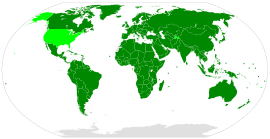
Back اتفاقية حقوق الأشخاص ذوي الإعاقة Arabic Əlillərin hüquqları haqqında Konvensiya Azerbaijani Úmluva OSN o právech osob se zdravotním postižením Czech FN's konvention om rettigheder for personer med handicap Danish Übereinkommen über die Rechte von Menschen mit Behinderungen German Konvencio pri la rajtoj de handikapitoj Esperanto Convención Internacional sobre los Derechos de las Personas con Discapacidad Spanish Puuetega inimeste õiguste konventsioon Estonian Desgaitasuna duten Pertsonen Eskubideei buruzko Nazioarteko Konbentzioa Basque کنوانسیون حقوق افراد دارای ناتوانی Persian
The Convention on the Rights of Persons with Disabilities is an international human rights treaty of the United Nations intended to protect the rights and dignity of persons with disabilities. Parties to the convention are required to promote, protect, and ensure the full enjoyment of human rights by persons with disabilities and ensure that persons with disabilities enjoy full equality under the law. The Convention serves as a major catalyst in the global disability rights movement enabling a shift from viewing persons with disabilities as objects of charity, medical treatment and social protection towards viewing them as full and equal members of society, with human rights.[1][2][3] The convention was the first U.N. human rights treaty of the twenty-first century.[4]
The text was adopted by the United Nations General Assembly on 13 December 2006,[5] and opened for signature on 30 March 2007. Following ratification by the 20th party, it came into force on 3 May 2008.[6] As of March 2024, it has 164 signatories and 191 parties, 190 states and the European Union (which ratified it on 23 December 2010).[7] The convention is monitored by the Committee on the Rights of Persons with Disabilities for which annual Conferences of States Parties to the CRPD have set guidelines since 2008. The thirteenth Conference of States Parties was scheduled to meet in New York in June 2020, then rescheduled tentatively to meet in December 2020[8] due to the COVID-19 crisis.[9]
- ^ Cite error: The named reference
:0was invoked but never defined (see the help page). - ^ Bantekas, Ilias; Stein, Michael Ashley; Anastasiou, Dēmētrēs, eds. (20 September 2018). The UN Convention on the Rights of Persons with Disabilities, a commentary (First ed.). Oxford University Press. ISBN 978-0-19-881066-7. OCLC 1041925625.
- ^ Adlakha, Roopali; Guha, Shouvik Kumar (2011). "Protecting the Disabled Persons under the Human Rights Regime - The Shift from Welfare to Rights". Journal of Indian Law & Society. 3: 67 – via Hein.
- ^ "General Assembly Adopts Groundbreaking Convention, Optional Protocol on Rights of Persons with Disabilities" (Press release). New York: United Nations. 13 December 2006.
- ^ United Nations General Assembly Session 61 Resolution 106. Convention on the Rights of Persons with Disabilities A/RES/61/106 13 December 2006. "alternate link: https://www.un.org/en/development/desa/population/migration/generalassembly/docs/globalcompact/A_RES_61_106.pdf"
- ^ "Landmark UN treaty on rights of persons with disabilities enters into force". Scoop. 5 May 2008. Retrieved 28 June 2008.
- ^ "UN Treaty Collection: parties to the Convention on the Rights of Persons with Disabilities: List of parties". United Nations. 12 October 2016. Retrieved 20 April 2017.
- ^ "Conference of States Parties to the Convention on the Rights of Persons with Disabilities". United Nations Department of Economic and Social Affairs. Retrieved 30 July 2020.
- ^ "Communication to Member States and other Stakeholders from the Secretariat of the Conference of the States Parties to the Convention on the Rights of Persons with Disabilities: Postponement of the thirteenth session of the Conference due to the worldwide outbreak of the COVID-19 pandemic to Member States and other stakeholders" (PDF). United Nations Department of Economic and Social Affairs. 23 March 2020. Retrieved 7 August 2020.
© MMXXIII Rich X Search. We shall prevail. All rights reserved. Rich X Search
